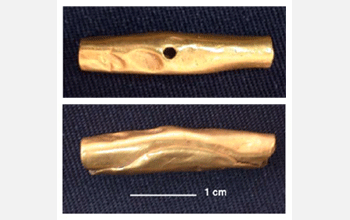Multimedia Gallery
Oldest Gold Artifact (Image 2)
Oldest Gold Artifact (Image 2)
A close-up view of the central bead in a turquoise and gold necklace that, at 4,000 years old, is currently the oldest worked gold artifact found in the Americas. The folding of the gold and hammer marks indicate how it was bent around a cylindrical form.
The necklace was discovered by Mark Aldenderfer, a professor of anthropology at The University of Arizona, and his research team, who excavated a site in the Peruvian Andes of South America, near Lake Titicaca. The site, Jiskairumoko, is located in a drainage basin where groups of hunters and gatherers were beginning to make the transition to a more settled existence. Dates for the Archaic period, when Jiskairumoko was inhabited by these people, are as early as 5,400 years ago and ending about 4,000 years ago.
The necklace may have belonged to someone with an elevated rank in the community. Carbon-14 dates for Jiskairumoko range from 2155 to 1936 B.C., making the necklace--at about 4,000 years old--some 600 years older than the previous earliest known gold artifacts in South America, or anywhere else in the Americas. The artist who created the Jiskairumoko necklace hammered gold until it was flat enough to roll into small cylindrical beads. The necklace has nine gold beads that are interspaced with several smaller green stones and a turquoise bead in the center. These materials were not available from the Titicaca Basin, requiring either a trade or a trip of some distance to acquire the gold and turquoise, or the finished necklace.
This research was supported by National Science Foundation grant SBR 98-16313
(Date of Image: 2002-2003) [See Related Image.]
Credit: Mark Aldenderfer, Department of Anthropology, University of Arizona
Images and other media in the National Science Foundation Multimedia Gallery are available for use in print and electronic material by NSF employees, members of the media, university staff, teachers and the general public. All media in the gallery are intended for personal, educational and nonprofit/non-commercial use only.
Images credited to the National Science Foundation, a federal agency, are in the public domain. The images were created by employees of the United States Government as part of their official duties or prepared by contractors as "works for hire" for NSF. You may freely use NSF-credited images and, at your discretion, credit NSF with a "Courtesy: National Science Foundation" notation.
Additional information about general usage can be found in Conditions.
Also Available:
Download the high-resolution TIF version of the image. (5.5 MB)
Use your mouse to right-click (Mac users may need to Ctrl-click) the link above and choose the option that will save the file or target to your computer.

